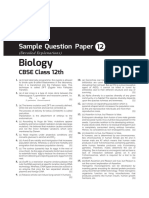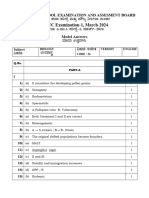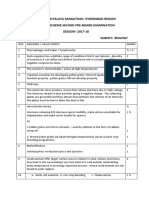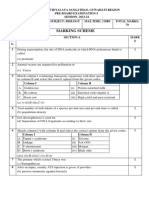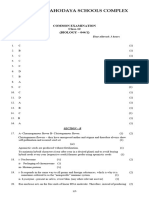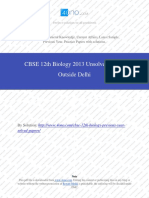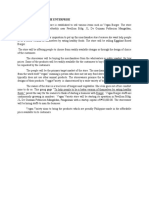Solution
BIOLOGY
Class 12 - Biology
Section A
1.
(b) Cotyledons and scutellum
Explanation:
The early stages of embryo development are similar in dicots and monocots. Dicots have two cotyledons while
monocots(grasses) have one cotyledon which is known as scutellum.
2.
(c) Blastocyst
Explanation:
Blastocyst
3. (a) Both A and R are true and R is the correct explanation of A.
Explanation:
The inner cell mass gets differentiated into an outer layer called ectoderm and an inner layer called endoderm. A mesoderm
soon appears between the ectoderm and the endoderm. These three layers give rise to all tissues (organs) in adults. It needs to
be mentioned here that the inner cell mass contains certain cells called stem cells which have the potency to give rise to all the
tissues and organs.
4.
(d) Arunachal Pradesh
Explanation:
Arunachal Pradesh
5.
(d) Pair B is incorrect
Explanation:
44 + XXY - Overall feminine development.
44 xxy syndrome is a genetic condition in males known as Klinefelter syndrome.
6. (a) DNA replication
Explanation:
DNA replication
7. (a) Biogenetic law
Explanation:
Biogenetic law
8. (a) Both A and R are true and R is the correct explanation of A.
Explanation:
Gene flow (also known as gene migration) is the transfer of genetic variation from one population to another. If the rate of gene
flow is high enough, then two populations are considered to have equivalent genetic diversity and therefore effectively a single
population.
9.
(b) Passive immunity
Explanation:
Passive immunity as it is provided by external source.
1/7
�10.
(b) Propionibacterium sharmanii
Explanation:
Propionibacterium sharmanii
11.
(d) A is false but R is true.
Explanation:
A is false but R is true.
12.
(d) 27
Explanation:
Basmati rice is distinct for its unique aroma and flavour and 27 documented varieties of Basmati are grown in India.
India grows 650,000 tonnes of Basmati annually.
13.
(c) One species is harmed while other is not affected.
Explanation:
One type of relationship that has been classified by biologists and ecologists is amensalism.
Amensalism is any relationship between organisms of different species in which one organism is inhibited or destroyed while
the other organism remains unaffected.
14. (a) Pyramid of standing crop
Explanation:
The ecological pyramids represent the trophic structure and also a trophic function of the ecosystem. In many ecological
pyramids, the producer form the base, and the successive trophic levels make up the apex.
The ecological pyramids may be of the following three kinds:
Pyramid of energy
Pyramid of biomass
Pyramid of number
15. (a) More than 15,500.
Explanation:
Nearly 700 species have become extinct in recent times and more than 15,500 species (of which > 650 are from India) which
includes amphibians, gymnosperms, reptiles, birds and mammals, etc. currently face the threat of extinction.
The causes of high extinction rates at present include habitat (particularly forests) loss and fragmentation, over-exploitation,
biological invasions, and co-extinctions.
16. (a) Both A and R are true and R is the correct explanation of A.
Explanation:
Both A and R are true and R is the correct explanation of A.
Section B
17. • In banana the vegetative propagation is with the help of rhizome
Values • Awareness
• Observations
OR
i. Pollen release and stigma receptivity not synchronised, either pollen released before the stigma is receptive or otherwise.
ii. Anther and stigma are placed at different position, stigma cannot come in contact with the pollen of the same flower.
iii. In some plant flowers are unisexual, male flower and female flower born on different plant.
iv. Self incompatibility, it is a genetic mechanism and prevents self pollen from fertilising the ovule by inhibiting pollen
germination or pollen tube growth in the pistil.
v. Many angiosperms possess genetic mechanisms that prevent self-pollination through self-incompatibility systems. These
systems recognize and reject pollen from the same plant, promoting cross-pollination.
2/7
�18. A set of positively charged proteins called histones, due to presence of lysine and arginine( basic amino acids), holds the
negatively charged DNA around it in a coiled manner, histones are organised to form a unit of eight molecules (histone octamer),
a typical nucleosome contains 200 bp of DNA helix, Nucleosomes constitute repeating units of a structure in nucleus called
chromatin thread (like bodies as “beads on string” structure in a nucleus). In this way enormous DNA is packed in a eukaryotic
cell.
OR
RNA polymerase II transcribe hnRNA in eukaryotes.
Steps of hnRNA undergoes before it is processed into mRNA are-
Capping- unusual nucleotide (methyl guanosine triphosphate) is added to the 5’ end of the hnRNA.
Tailing-adenylate residues are added at 3’ end in a template independent manner.
19. (I) Streptokinase is used to dissolve blood clots that have formed in the blood vessels. It is used immediately after symptoms of a
heart attack occur to improve patient survival. This medicine may also be used to treat blood clots in the lungs (pulmonary
embolism) and in the legs (deep venous thrombosis).
(ii) Lactic acid is used as a food preservative, curing agent, and flavoring agent. It is an ingredient in processed foods and is used
as a decontaminant during meat processing.
(iii) Ethanol fermentation, also called alcoholic fermentation, is a biological process which converts sugars such as glucose,
fructose, and sucrose into cellular energy, producing ethanol and carbon dioxide as a side-effect.
20. i. Proinsulin Insulin
Proinsulin is a single polypeptide chain of 86 amino Insulin is composed of an A chain of 21 amino acids and a B
acids that permits correct alignment of three pairs of chain of 30 amino acids, the chains being held together by two
disulfide bonds. disulfide bonds.
ii. In 1983, Eli Lily, an American company, prepared two DNA sequences corresponding to A and B chains of human insulin and
introduced them in the plasmids of E. coli to produce insulin chains. Chains A and B were produced separately, extracted and
combined by creating disulphide bonds to form human insulin.
21. Fragmentation is the process of breakdown of detritus in which a part of detritus is eaten by detritivores (such as
earthworms) and comes out in the highly pulverized state in their feces.
Catabolism is carried out by saprotrophic bacteria and fungi. They secrete digestive enzymes over the fragmented detritus.
The enzymes change complex organic compounds into simple compounds and inorganic substances are also released in
this process.
OR
a. Grazing Food chain Detritus Food Chain
Begins with producers Begins with dead organic matter/detritus
Second trophic level is occupied by herbivores Second trophic level is occupied by detrivores
Major conduit for energy flow in aquatic ecosystem Major conduit for energy flow in terrestrial ecosystem
b. Some organisms of DFC are prey to GFC animals and in a natural ecosystem some animals like cockroach or crow etc. are
omnivores.
Section C
22. Different stages of development of Graffian follicle are as follows:
a. Primary Follicle
b. Secondary Follicle
3/7
� c. Tertiary Follicle
d. Graffan Follicle
23. (a) Yes, it was necessary to stop the act since as per the government order, the minimum marriageable age of a girl is 18 years.
(b) Ratan thought of the following Disadvantages of early marriage: (Any two)
Forced sexual relation and denial of freedom with restriction to family bindings.
Domestic violence
Denial of education
Reproductive health problems
Teenage pregnancy
Child birth associated trauma
High postnatal mortality
Population pressure, health costs, human development loss
Health costs
Early widowhood,
(c) Sense of responsibility and consciousness for his family and respect of government laws. He expressed his views boldly for the
right cause.
24. Haemophilia is a sex disease present on recessive X chromosome. For a daughter to be haemophilic mother should be a carrier
and father should be haemophilic. A female becomes haemophilic only when both its X chromosomes carry the gene. However,
such females generally die before birth because the combination of these two recessive alleles is lethal. If the gene is present on
the X chromosomes, then the female appears normal. Hence, it is very rare for a female to be haemophilic.
25. VNTR (Variable Number Tandem Repeat) is a location in the genome where a short nucleoside is organized as a tandem repeat.
Analysis of VNTR is used for many purposes; including DNA fingerprinting. But bacteriophage does not have too many DNAs
rather only a few strands of DNA are available in bacteriophage. This does not leave scope for repeating sequences in DNA.
Hence, VNTR cannot be used in DNA finger-printing of a bacteriophage.
26. a. ELISA Test - ELISA, which stands for Enzyme-Linked Immunosorbent Assay, is used to detect HIV infection.
Principle of working of ELISA:
ELISA works on the principle that specific antibodies bind the target antigen and detect the presence and quantity of antigens
binding. In order to increase the sensitivity and precision of the assay, the plate must be coated with antibodies with high
affinity. ELISA can provide a useful measurement of antigen-antibody concentration.
b. The core of HIV (Human immunodeficiency virus) contains two molecules of single stranded RNA (as genetic material) and
reverse transcriptase.
27. Biological control means life against life. It is a natural and eco-friendly concept. It employs the natural organisms to control the
population of pathogens and pests in an ecosystem. Classical examples are Trichoderma which is antagonist against many soil-
borne Plant Pathogens. Similarly, Penicillium inhibits the growth of Staphylococcus and, therefore, has been successfully used in
the production of Penicillin antibiotic to control many human bacterial pathogens.
28. Expanding age pyramid Stable age pyramid
4/7
� The population of pre-reproductive age is greater than population The population of pre-reproductive age equals to population
of reproductive age of reproductive age
Section D
29. i. Three (one vegetative nucleus and two male nuclei)
ii. 1600 male gametophyte
iii. Meiosis occurs in 1
OR
A malfunctioning tapetum is not able to provide optimum nutrition for the production of viable male gametophytes.
30. i. Long life span lead to less adaptability, so less chance of natural selection.
Short life span lead to more adaptability, so more chance of natural selection.
ii. As nature select a population; in upcoming time it will lead to make a new species. So by this way natural selection and
speciation are linked.
iii. 50%
OR
Yes, adaptive abilities are inherited.
Section E
31. a. Two reasons for infertility in couples, aside from physical and congenital disorders, include hormonal
imbalances/immunological, and lifestyle factors like diseases/drugs and psychological.
b. In in-vitro fertilisation, the fertilisation takes place outside the body followed by embryo transfer
in this method ova from wife/donor and sperms from husband/donor are collected and induced to form zygote in the lab,
zygote/early embryo is transferred into the fallopian tube, embryos with more than 8 blastomeres, are transferred into the
uterus for further development.
c. GIFT - Transfer of an ovum collected from a donor into the fallopian tube of another female who cannot produce one
ICSI - Specialised procdure to form embryo by injecting sperm directly into the ovum.
OR
i. Ova from the wife /donor (female) and sperms from the husband / donor (male) are collected and induced to form zygote in
simulated conditions in laboratory. The zygote/ early embryos (up to 8 blastomeres) then transferred into the fallopian tube
(ZIFT) and embryos with more than 8 blastomeres into the iuterus, (IUT) to complete its further development.
ii. No, GIFT cannot be considered as IVF technique because fertilisation takes place in the female body / in vivo.
32. a. (Isolation of genetic material) Fungal cells were treated with chitinase, RNA to be removed by treating with RNAase,
protein was removed by treating with protease, and then addition of chilled ethanol.
Cutting of DNA at specific locations by restriction enzymes.
fragments are separated by gel electrophoresis
b. Multiple copies of separated genes of interest is synthesized by following steps of the method given below: PCR (polymerase
chain reaction) Denaturation, Annealing, Extension ( followed by amplification)
5/7
� i. Polymerase chain reaction/PCR
ii. Multiple copies of separated genes of interest are synthesized by following the given below method: rDNA technology,
same restriction enzyme cutting both foreign DNA and vector DNA at specific point, ligases join foreign DNA to Plasmid,
transformation (cell divides and helps in multiplication of genes)
OR
i. Optimisation of the bioreactor system can be achieve by Temperature, pH, Substrate, Salts, Vitamins, Oxygen
ii. Log phase/Exponential phase is referred
iii. No
It needs separation and purification/down-streaming process/quality control testing/needs to be formulated with suitable
preservatives/clinical trials.
33. i. Population density means a number of individuals present per unit area, population density can be measured by determining
the population size.
Ecologists are interested in measuring population density for the following reasons:
a. The size of the population tells us a lot about its status in the habitat.
b. Ecological processes such as the outcome of competition with another species, the impact of a predator or the effect of
pesticide application can be easily evaluated in terms of change in the population size.
ii. The different methods to study population size are as follows:
a. Percent cover or Biomass: In an area with 200 Parthenium plants and only one banyan tree with a large canopy, the
density of banyan tree is small but does not reflect its important role in the community. Here the percent cover or biomass
is a more meaningful method of assessing population density.
b. Total number: It involves the counting of organisms in the given area.
6/7
� c. Relative density: In this method, there is no need to count the organisms individually. Example, the number of fishes
caught per trap gives the measure of their total density m a given waterbody.
d. Indirect assessment: The tiger census is based on pugmarks and faecal pellets.
OR
a. Population refers to the group of potentially interbreeding individuals of a species living together in a group in a well-defined
geographical area, sharing or competing for similar resources. Although the term interbreeding implies sexual reproduction, a
group of individuals resulting from even asexual reproduction is also considered a population.
b. The size of a population of any species is not a static parameter. It keeps changing with time, affected by various factors
including food availability, predation pressures, and weather. The population density of a region in a given period can
fluctuate due to the following four factors:
i. Natality: It is the number of births during a given period in the population that are added to its initial density.
ii. Mortality: It is the number of deaths during a given period resulting in the reduction of its initial density.
iii. Immigration: It is the number of individuals of the same species that have come into the habitat from elsewhere during
the period under consideration and resulting in addition to population's initial density.
iv. Emigration: It is the number of individuals of the population who left the habitat and have gone elsewhere during the time
period under consideration. It decreases the population's initial density.
7/7






